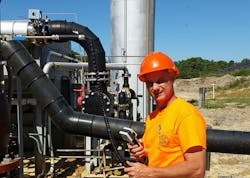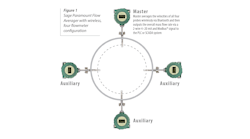Solid Waste Facility Benefits from Portable Thermal Mass Flowmeter
2015 Flow Control Innovation Winner:
Sage Portable Datalogging Thermal Mass Flow Meter — By Sage Metering
The Cape May County Municipal Utility Authority (CMCMUA) launched its Landfill Gas to Energy Project in the late 1990s. Since 2000, more than 2.1 billion cubic feet of landfill gas (LFG) has been captured and sold as a sustainable energy.
The CMCMUA was seeking a low-cost solution that would permit it to operate its Sanitary Landfill in Woodbine, New Jersey, as efficiently as possible. The existing plant layout contains landfill gas lines of six various diameters (2", 3", 4", 6", 8", 10" and 12"). Because the LFG contains toxic hydrogen sulfide (H2S), it must be processed in scrubber tanks and stripped of H2S before feeding into boilers and generators found at the plant. It was suspected that the flow to the scrubber may have exceeded the maximum flow rate of the vessel (300 SCFM).
Randy Handlovsky, an LFG system operator at CMCMUA, wanted to ensure maximum efficiency on his power generators and boilers without exceeding the capabilities of the scrubber tanks. After evaluating his options, Handlovsky selected the second-generation Sage Prism by Sage Metering. The portable thermal mass flowmeter with data-logging capabilities offered a substantial cost-savings approach versus purchasing flowmeters for each LFG line.
The Prism thermal mass flowmeter is capable of measuring the flow of all the landfill gas lines. A ball valve and compression fitting are used to establish a branch connection where the Prism can be safely inserted into a live pipe. The Prism is portable and easy to operate. It is ideal for energy monitoring of biogas and landfill gas. With the ability to hold 130,000 data points, the Prism can be used for periodic sampling and long-term trend analysis. Each data point includes log number, date and time of the sample, mass flow rate, and the gas temperature.
"I tried the meter, and it works," Handlovsky says. By using the Sage Prism, Handlovsky was able to confirm his landfill gas production rate exceeded the maximum flow rating of the hydrogen sulfide scrubber. The Prism offers the CMCMUA the ability to monitor the flow of varying-sized lines without the substantial expense of flowmeters on each line. By ascertaining flow rates, the company can adjust production to reduce maintenance costs, and protect and extend the life of its capital equipment.
The second-generation Sage Prism is expected to be fully released by the end of October 2015.
Read more case studies from 2015 Flow Control Innovation Award winner here.


